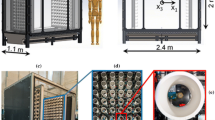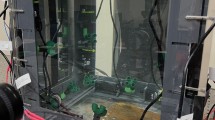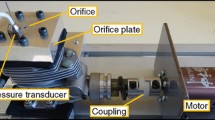Abstract
This paper investigates turbulence generated by an array of opposed piston-driven synthetic jet actuators in a closed chamber. Each actuator intermittently generates supersonic jets with four orifice holes, and the interaction of 32 supersonic jets produces turbulence. Velocity measurement is conducted with particle image velocimetry using oil mist as the tracer particles, which are internally generated by the synthetic jet actuators. The turbulence with a small mean velocity is generated at the central region of the chamber, where the root-mean-square (rms) velocity fluctuations are also almost uniform in space. The rms velocity fluctuations around the chamber center are about 1.2 times larger in the jet direction than in other directions. The strongly intermittent nature of supersonic synthetic jets causes large-scale intermittency of turbulence. The turbulent Reynolds number and turbulent Mach number reach \(O(10^3)\) and \(O(10^{-2})\), respectively, at the chamber center. Although the turbulent Mach number at the chamber center is not large, the generation process of turbulence due to the supersonic jets is strongly influenced by compressibility. Therefore, density variations exist in turbulence, where the shadowgraph image exhibits the brightness distribution with a characteristic length scale related to the Kolmogorov scale. The shape of longitudinal velocity auto-correlation functions and the relation between the turbulent Reynolds number and velocity derivative flatness agree well with previous studies on incompressible turbulence.
Graphical abstract


















Similar content being viewed by others
References
Agui JH, Briassulis G, Andreopoulos Y (2005) Studies of interactions of a propagating shock wave with decaying grid turbulence: velocity and vorticity fields. J Fluid Mech 524:143–195
Alvelius K (1999) Random forcing of three-dimensional homogeneous turbulence. Phys Fluids 11(7):1880–1889
Anas M, Joshi P, Verma MK (2020) Freely decaying turbulence in a finite domain at finite Reynolds number. Phys Fluids 32(9):095109
Antonia RA, Chambers AJ (1980) On the correlation between turbulent velocity and temperature derivatives in the atmospheric surface layer. Boundary-Layer Meteorol 18(4):399–410
Assoudi A, Saïd NM, Bournot H, Le Palec G (2019) Comparative study of flow characteristics of a single offset jet and a turbulent dual jet. Heat Mass Transf 55(4):1109–1131
Bellani G, Variano EA (2014) Homogeneity and isotropy in a laboratory turbulent flow. Exp Fluids 55(1):1–12
Beresh S, Kearney S, Wagner J, Guildenbecher D, Henfling J, Spillers R, Pruett B, Jiang N, Slipchenko M, Mance JSR (2015) Pulse-burst PIV in a high-speed wind tunnel. Meas Sci Tech 26(9):095305
Bharath BK (2015) Design and fabrication of a supersonic wind tunnel. Int J Eng Appl Sci 2(5):257914
Birouk M, Sarh B, Gökalp I (2003) An attempt to realize experimental isotropic turbulence at low Reynolds number. Flow Turbul Combust 70(1–4):325–348
Bonnet JP, Jayaraman V, De Roquefort TA (1984) Structure of a high-Reynolds-number turbulent wake in supersonic flow. J Fluid Mech 143:277–304
Bradley D, Lawes M, Morsy ME (2019) Measurement of turbulence characteristics in a large scale fan-stirred spherical vessel. J Turbul 20(3):195–213
Briassulis G, Agui JH, Andreopoulos Y (2001) The structure of weakly compressible grid-generated turbulence. J Fluid Mech 432:219–283
Carter D, Petersen A, Amili O, Coletti F (2016) Generating and controlling homogeneous air turbulence using random jet arrays. Exp Fluids 57(12):1–15
Clemens NT, Mungal MG (1995) Large-scale structure and entrainment in the supersonic mixing layer. J Fluid Mech 284:171–216
Comte-Bellot G, Corrsin S (1966) The use of a contraction to improve the isotropy of grid-generated turbulence. J Fluid Mech 25(4):657–682
Crittenden TM, Glezer A (2006) A high-speed, compressible synthetic jet. Phys Fluids 18(1):017107
Davidson PA (2004) Turbulence: an introduction for scientists and engineers. Oxford Univ
De Silva IPD, Fernando HJS (1994) Oscillating grids as a source of nearly isotropic turbulence. Phys Fluids 6(7):2455–2464
Djenidi L, Kamruzzaman M, Antonia RA (2015) Power-law exponent in the transition period of decay in grid turbulence. J Fluid Mech 779:544–555
Donzis DA, John JP (2020) Universality and scaling in homogeneous compressible turbulence. Phys Rev Fluids 5(8):084609
Fincham AM, Maxworthy T, Spedding GR (1996) Energy dissipation and vortex structure in freely decaying, stratified grid turbulence. Dyn Atmos Oceans 23(1–4):155–169
Gilarranz JL, Traub LW, Rediniotis OK (2005) A new class of synthetic jet actuators-part I: design, fabrication and bench top characterization. ASME J Fluids Eng 127(2):367–376
Goepfert C, Marié JL, Chareyron D, Lance M (2010) Characterization of a system generating a homogeneous isotropic turbulence field by free synthetic jets. Exp Fluids 48(5):809–822
Honkan A, Andreopoulos J (1992) Rapid compression of grid-generated turbulence by a moving shock wave. Phys Fluids 4(11):2562–2572
Hopfinger EJ, Toly JA (1976) Spatially decaying turbulence and its relation to mixing across density interfaces. J Fluid Mech 78(1):155–175
Hwang W, Eaton JK (2004) Creating homogeneous and isotropic turbulence without a mean flow. Exp Fluids 36(3):444–454
Hwang W, Eaton JK (2006) Homogeneous and isotropic turbulence modulation by small heavy (\({St}\sim 50\)) particles. J Fluid Mech 564:361
Jimenez J, Wray AA (1998) On the characteristics of vortex filaments in isotropic turbulence. J Fluid Mech 373:255–285
Kang HS, Chester S, Meneveau C (2003) Decaying turbulence in an active-grid-generated flow and comparisons with large-eddy simulation. J Fluid Mech 480:129–160
Keller J, Merzkirch W (1990) Interaction of a normal shock wave with a compressible turbulent flow. Exp Fluids 8(5):241–248
Kerr RM (1985) Higher-order derivative correlations and the alignment of small-scale structures in isotropic numerical turbulence. J Fluid Mech 153:31–58
Kitamura T, Nagata K, Sakai Y, Sasoh A, Terashima O, Saito H, Harasaki T (2014) On invariants in grid turbulence at moderate Reynolds numbers. J Fluid Mech 738:378–406
Klewicki JC, Hirschi CR (2004) Flow field properties local to near-wall shear layers in a low Reynolds number turbulent boundary layer. Phys Fluids 16(11):4163–4176
Kouchi T, Iwachido M, Nakagawa T, Nagata Y, Yanase S (2020) Transverse jet mixing in a supersonic grid turbulence. In: Proceedings of the AIAA Scitech 2020 Conference, p 2040
Kovasznay LSG (1950) The hot-wire anemometer in supersonic flow. J Aero Sci 17(9):565–572
Krawczynski JF, Renou B, Danaila L (2010) The structure of the velocity field in a confined flow driven by an array of opposed jets. Phys Fluids 22(4):045104
Krogstad PÅ, Davidson PA (2010) Is grid turbulence saffman turbulence? J Fluid Mech 642:373
Kuo AYS, Corrsin S (1971) Experiments on internal intermittency and fine-structure distribution functions in fully turbulent fluid. J Fluid Mech 50(2):285–319
Marié JL, Tronchin T, Grosjean N, Méès L, Öztürk OC, Fournier C, Barbier B, Lance M (2017) Digital holographic measurement of the Lagrangian evaporation rate of droplets dispersing in a homogeneous isotropic turbulence. Exp Fluids 58(2):11
Mi J, Xu M, Zhou T (2013) Reynolds number influence on statistical behaviors of turbulence in a circular free jet. Phys Fluids 25(7):075101
Mydlarski L, Warhaft Z (1996) On the onset of high-Reynolds-number grid-generated wind tunnel turbulence. J Fluid Mech 320(1):331–368
Nasr A, Lai J (1997) Comparison of flow characteristics in the near field of two parallel plane jets and an offset plane jet. Phys Fluids 9(10):2919–2931
Ozono S, Ikeda H (2018) Realization of both high-intensity and large-scale turbulence using a multi-fan wind tunnel. Exp Fluids 59(12):1–12
Pérez-Alvarado A, Mydlarski L, Gaskin S (2016) Effect of the driving algorithm on the turbulence generated by a random jet array. Exp Fluids 57(2):20
Praud O, Fincham AM, Sommeria J (2005) Decaying grid turbulence in a strongly stratified fluid. J Fluid Mech 522:1–33
Ravi S, Peltier SJ, Petersen EL (2013) Analysis of the impact of impeller geometry on the turbulent statistics inside a fan-stirred, cylindrical flame speed vessel using piv. Exp Fluids 54(1):1424
Sakakibara H, Watanabe T, Nagata K (2018) Supersonic piston synthetic jets with single/multiple orifice. Exp Fluids 59(5):76
Scarano F, Van Oudheusden BW (2003) Planar velocity measurements of a two-dimensional compressible wake. Exp Fluids 34(3):430–441
Semenov ES (1965) Measurement of turbulence characteristics in a closed volume with artificial turbulence. Combust Explos ShockWaves 1(2):57–62
Sreenivasan KR, Antonia RA (1997) The phenomenology of small-scale turbulence. Ann Rev Fluid Mech 29(1):435–472
Takamure K, Ozono S (2019) Relative importance of initial conditions on outflows from multiple fans. Phys Rev E 99(1):013112
Tamba T, Fukushima G, Kayumi M, Iwakawa A, Sasoh A (2019) Experimental investigation of the interaction of a weak planar shock with grid turbulence in a counter-driver shock tube. Phys Rev Fluids 4(7):073401
Thompson SM, Turner JS (1975) Mixing across an interface due to turbulence generated by an oscillating grid. J Fluid Mech 67(2):349–368
Traub LW, Sweet M, Nilssen K (2012) Evaluation and characterization of a lateral synthetic jet actuator. J Aircraft 49(4):1039–1050
Uberoi MS, Wallis S (1967) Effect of grid geometry on turbulence decay. Phys Fluids 10:1216–1224
Valente PC, Vassilicos JC (2011) The decay of turbulence generated by a class of multiscale grids. J Fluid Mech 687:300–340
Valente PC, Onishi R, da Silva CB (2014) Origin of the imbalance between energy cascade and dissipation in turbulence. Phys Rev E 90(2):023003
Van Atta CW, Antonia RA (1980) Reynolds number dependence of skewness and flatness factors of turbulent velocity derivatives. Phys Fluids 23(2):252–257
Variano EA, Cowen EA (2008) A random-jet-stirred turbulence tank. J Fluid Mech 604:1–32
Variano EA, Bodenschatz E, Cowen EA (2004) A random synthetic jet array driven turbulence tank. Exp Fluids 37(4):613–615
Veeravalli S, Warhaft Z (1989) The shearless turbulence mixing layer. J Fluid Mech 207:191–229
Watanabe T, Nagata K (2018) Integral invariants and decay of temporally developing grid turbulence. Phys Fluids 30(10):105111
Watanabe T, Zhang X, Nagata K (2019) Direct numerical simulation of incompressible turbulent boundary layers and planar jets at high Reynolds numbers initialized with implicit large eddy simulation. Comput Fluids 194:104314
Watanabe T, Tanaka K, Nagata K (2020) Characteristics of shearing motions in incompressible isotropic turbulence. Phys Rev Fluids 5(7):072601
Watanabe T, Tanaka K, Nagata K (2021) Solenoidal linear forcing for compressible, statistically steady, homogeneous isotropic turbulence with reduced turbulent mach number oscillation. Phys Fluids 33(9):095108
Wernet MP (2007) Temporally resolved PIV for space-time correlations in both cold and hot jet flows. Meas Sci Tech 18(5):1387
Wernet MP (2016) Application of Tomo-PIV in a large-scale supersonic jet flow facility. Exp Fluids 57(9):144
Williams O, Van Buren T, Smits AJ (2015) A new method for measuring turbulent heat fluxes using PIV and fast-response cold-wires. Exp Fluids 56(7):1–10
Wu J, Radespiel R (2017) Damping insert materials for settling chambers of supersonic wind tunnels. Exp Fluids 58(3):19
Xiang X, Madison TJ, Sellappan P, Spedding GR (2015) The turbulent wake of a towed grid in a stratified fluid. J Fluid Mech 775:149–177
Xu S, Huang S, Huang R, Wei W, Cheng X, Ma Y, Zhang Y (2017) Estimation of turbulence characteristics from PIV in a high-pressure fan-stirred constant volume combustion chamber. Appl Therm Eng 110:346–355
Yap CT, Van Atta CW (1993) Experimental studies of the development of quasi-two-dimensional turbulence in stably stratified fluid. Dyn Atmos Oceans 19(1–4):289–323
Yoffe SR, McComb WD (2018) Onset criteria for freely decaying isotropic turbulence. Phys Rev Fluids 3(10):104605
Zimmermann R, Xu H, Gasteuil Y, Bourgoin M, Volk R, Pinton J, Bodenschatz E (2010) The Lagrangian exploration module: An apparatus for the study of statistically homogeneous and isotropic turbulence. Rev Sci Instrum 81(5):055112
Zwart PJ, Budwig R, Tavoularis S (1997) Grid turbulence in compressible flow. Exp Fluids 23(6):520–522
Acknowledgements
The authors acknowledge Mr. H. Sakakibara for his help in developing the piston-driven synthetic jet actuators. This work was supported by JSPS KAKENHI Grant Number 18H01367, Paloma Environmental Technology Development Foundation, and Tatematsu Foundation.
Author information
Authors and Affiliations
Corresponding author
Ethics declarations
Conflict of interest
The authors declare that they have no conflict of interest.
Additional information
Publisher's Note
Springer Nature remains neutral with regard to jurisdictional claims in published maps and institutional affiliations.
Appendix: Effects of spatial resolution
Appendix: Effects of spatial resolution
The PIV measurement conducted in this study has a spatial resolution of \(10\eta\)-\(20\eta\). The effects of the unresolved velocity fluctuations on velocity statistics are assessed with direct numerical simulation (DNS) of incompressible turbulence. Here, we use the DNS database of a temporally evolving turbulent planar jet with the jet Reynolds number of 40,000 (Watanabe et al. 2019). An energy spectrum of streamwise velocity fluctuations \(E_u(k_x)\) is calculated on the jet centerline, where \(k_x\) is the streamwise wavenumber. We define the cutoff wavenumber as \(k_C=2\pi /C\eta _0\) with a parameter C and the Kolmogorov scale \(\eta _0\). Here, \(\eta _0\) is calculated with the turbulent kinetic energy dissipation rate \(\varepsilon =2\nu \overline{S_{ij}S_{ij}}\), where \(S_{ij}\) is the rate-of-strain tensor. Streamwise velocity variance at the scales greater than \(C\eta _0\) is evaluated as \(\overline{{u'}^2}(C)=\int _0^{k_C}E_u(k_x)dk_x\). Similarly, the variance of \(\partial u /\partial x\) at scales greater than \(C\eta _0\) is given by \(\overline{(\partial u' /\partial x)^2}(C)=\int _0^{k_C}k_x^2E_u(k_x)dk_x\). Then, the turbulent Reynolds number \(Re_\lambda (C)\) and Kolmogorov scale \(\eta (C)\) of the filtered velocity are calculated with \(\overline{{u'}^2}(C)\) and \(\overline{(\partial u' /\partial x)^2}(C)\):
Figure 17 shows the cutoff-length dependence of \(\overline{{u'}^2}(C)\), \(Re_\lambda (C)\), and \(\eta (C)\) normalized by their values for \(C=1\). As C increases, the range of the unresolved scale becomes wider. Because velocity fluctuations are dominated by large-scale turbulent motions, \(\overline{{u'}^2}(C)/\overline{{u'}^2}(1)\) stays 1 even for \(C=30\). \(Re_\lambda (C)\) and \(\eta (C)\) increase with C. However, \(Re_\lambda (C)/Re_\lambda (1)\) and \(\eta (C)/\eta (1)\) are less than 1.3 even at \(C=30\). Thus, the present PIV measurement with the spatial resolution of 10–\(20\eta\) is still useful for the approximate estimation of turbulent Reynolds number and Kolmogorov scale.
Rights and permissions
About this article
Cite this article
Yamamoto, K., Watanabe, T. & Nagata, K. Turbulence generated by an array of opposed piston-driven synthetic jet actuators. Exp Fluids 63, 35 (2022). https://doi.org/10.1007/s00348-021-03351-z
Received:
Revised:
Accepted:
Published:
DOI: https://doi.org/10.1007/s00348-021-03351-z




